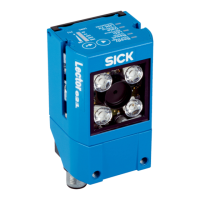86 COB-ID RPDO user Dig. Input
The COB-ID RPDO user Dig. Input parameter defines the CAN identifier for the user-
defined receive process data objects (RPDOs) received on the reading device.
For the first four receive process data objects (RPDOs), communication and mapping
can be configured by accessing objects 0x1400 to 0x1403 and 0x1600 to 0x1603.
The configuration is saved in the device's parameter set. The other RPDOs cannot be
configured.
87 COB-ID RPDO Dig. Input
The COB-ID RPDO Dig. Input parameter defines the CAN identifier for the receive proc‐
ess data objects (RPDOs) received on the reading device.
88 COB-ID TPDO user Dig. Output
The COB-ID TPDO user Dig. Output parameter defines the CAN identifier for the user-
defined transmit process data objects (TPDOs) sent by the reading device.
89 COB-ID TPDO Dig. Output
The COB-ID TPDO Dig. Output parameter defines the CAN identifier for the transmit
process data objects (TPDOs) sent by the reading device.
For the first four transmit process data objects (TPDOs), communication and mapping
can be configured by accessing objects 0x1800 to 0x1803 and 0x1A00 to 0x1A03.
This task is normally performed by a CANopen control. The configuration is saved in the
device's parameter set.
Objects TPDO6 to TPDO12 are used to output the reading result and cannot be config‐
ured.
NOTE
It is recommended to use TPDO2 to TPDO4 for user-defined applications. Object TPDO1
is used for synchronization. TPDO1 is used to signal the availability of data that can be
retrieved by the service data object client (SDO client) via an SDO upload access.
SOPAS PARAMETER OVERVIEW
40
O N L I N E H E L P | Lector62x 8013778/YPV6/2016-01-14 | SICK
Subject to change without notice

